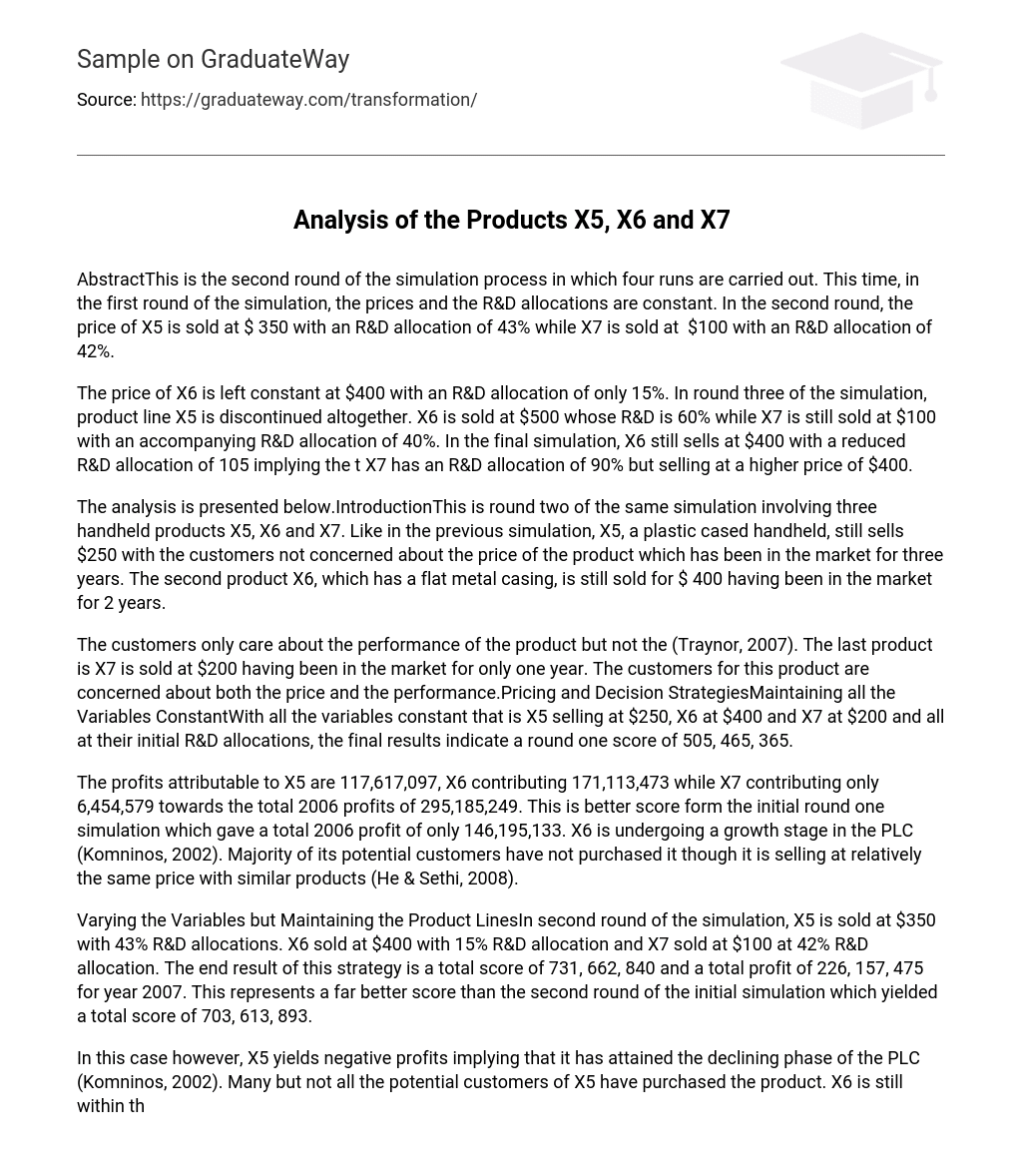Abstract
This is the second round of the simulation process in which four runs are carried out. This time, in the first round of the simulation, the prices and the R&D allocations are constant. In the second round, the price of X5 is sold at $ 350 with an R&D allocation of 43% while X7 is sold at $100 with an R&D allocation of 42%.
The price of X6 is left constant at $400 with an R&D allocation of only 15%. In round three of the simulation, product line X5 is discontinued altogether. X6 is sold at $500 whose R&D is 60% while X7 is still sold at $100 with an accompanying R&D allocation of 40%. In the final simulation, X6 still sells at $400 with a reduced R&D allocation of 105 implying the t X7 has an R&D allocation of 90% but selling at a higher price of $400. The analysis is presented below.
Introduction
This is round two of the same simulation involving three handheld products X5, X6 and X7. Like in the previous simulation, X5, a plastic cased handheld, still sells $250 with the customers not concerned about the price of the product which has been in the market for three years. The second product X6, which has a flat metal casing, is still sold for $ 400 having been in the market for 2 years.
The customers only care about the performance of the product but not the (Traynor, 2007). The last product is X7 is sold at $200 having been in the market for only one year. The customers for this product are concerned about both the price and the performance.
Pricing and Decision Strategies
With all the variables constant that is X5 selling at $250, X6 at $400 and X7 at $200 and all at their initial R&D allocations, the final results indicate a round one score of 505, 465, 365.
The profits attributable to X5 are 117,617,097, X6 contributing 171,113,473 while X7 contributing only 6,454,579 towards the total 2006 profits of 295,185,249. This is better score form the initial round one simulation which gave a total 2006 profit of only 146,195,133. X6 is undergoing a growth stage in the PLC (Komninos, 2002). Majority of its potential customers have not purchased it though it is selling at relatively the same price with similar products (He & Sethi, 2008).
Varying the Variables but Maintaining the Product LinesIn second round of the simulation, X5 is sold at $350 with 43% R&D allocations. X6 sold at $400 with 15% R&D allocation and X7 sold at $100 at 42% R&D allocation. The end result of this strategy is a total score of 731, 662, 840 and a total profit of 226, 157, 475 for year 2007. This represents a far better score than the second round of the initial simulation which yielded a total score of 703, 613, 893.
In this case however, X5 yields negative profits implying that it has attained the declining phase of the PLC (Komninos, 2002). Many but not all the potential customers of X5 have purchased the product. X6 is still within the growth stage of the PLC and performing better that the similar products despite the fact that not all the potential customers have purchased it (He & Sethi, 2008). Discontinue Product Line X5Having reached the declining stage in the PLC, X5 is dropped.
This has the implication that the declining phase of a product usually comes with a reduction in its market sales (Komninos, 2002). Instead, X6 is sold at $500 with an increased R&D allocation of 60%. Similarly, X7 is allocated a higher 40% for R&D but sold at $100. The end result of this strategy is a score of 1, 152, 320, 831 and a total profit for 2008 of 420, 607, 992.
This is once more a better score as opposed to the initial round three 2008 profits of 239, 998, 999 in the first simulation.The implication here is that X6 has reached its declining stage while X7 is steadily competing in the market. X6 is no longer appealing to new customers thus it can only be sold to old customers thus repeat sakes with no new sales (Komninos, 2002). In the final simulation, X6 is sols at $400 but with only 10% R&D allocation.
On the contrary, X7 is sold at $400 with 90% R&D allocation. The end result having run the final simulation gives a cumulative score of 1, 085, 949, 162 representing an improvement from the 1, 085, 474, 139 cumulative score of the first simulation.
Conclusion
What can be deduced from this simulation is that X5 was initially the highest selling of the handhelds before reaching the declining stage of the PLC and being unprofitable thereby justifying the decision to drop its product line. X6 started and ended the simulation as a profitable product.
This can be drawn for the fact that its customers value performance as opposed to the price at which it is sold (He & Sethi, 2008). Having been in the market for only 2 years, the product mainly operated at its growth stage though it eventually reached the declining stage (Komninos, 2002). Finally, X7 was mainly a product undergoing growth, the implication being that many potential customers who would have adopted the product did not get the chance to do so. This explains the reason it was unprofitable at the end of the simulation.
References
- Allen, S. (2008). Pricing Strategy: How Much should You Charge for YourProduct. Retrieved December 31, 2008 from http://www.markitek.com/articles/pricing.htmHe, H and Sethi, S. (2008).
- Dynamic Slotting and Pricing in a Durable ProductSupply Chain. Journal of Optimization Theory and Applications, Vol.136 (3). Retrieved 31 December 2008 from SSRN http://ssrn.com/abstract=1087804Komninos, I. (2002). Product Life Cycle Management. URENIO- Unrban andRegional Innovation Research Unit.
- Retrieved 31 Dec. 2008 from http://209.85.175.132/searchq=cache:yWongSlShawJ:www.urenio.org/tools/en/Product_Life_Cycle_Management.pdf+product+pricing+in+product+life+cycles&hl=en&ct=clnk&cd=7&gl=ke&client=firefox-aTraynor, I.(2007). Product Life Cycles- Developing Your Product Strategy.Retrieved December 31, 2008 from http://www.jobbankusa.com/CareerArticles/Marketing/ca102907a.html





